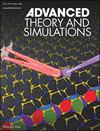解析c2sni₆钙钛矿太阳能电池的高效:基于第一性原理计算和SCAPS建模的综合研究
IF 2.9
4区 工程技术
Q1 MULTIDISCIPLINARY SCIENCES
引用次数: 0
摘要
Cs₂SnI₆已成为铅(Pb)基钙钛矿太阳能电池(PSCs)的稳定和环保替代品,因为它的空气稳定性,归因于Sn⁴氧化态,以及无毒成分(无铅)。使用Cs₂SnI₆作为吸收层的一个关键好处是,它可以在某些设备架构中消除空穴传输层(HTLs);然而,带有html的psc通常比没有html的psc表现更好。本文采用第一性原理计算方法研究了Cs₂SnI₆的结构、电子和光学性质,并利用SCAPS-1D模拟软件研究了其光伏效应。通过将三个电子传输层(etl)与三个html相结合,研究了九种不同的器件配置,以优化器件性能。研究了HTL厚度、ETL厚度、吸收层厚度和工作温度对太阳能电池效率的影响。优化后的PSC填充系数(FF)为84.683%,功率转换效率(PCE)为24.0%,短路电流密度JSC为28.433 mA cm−2,开路电压VOC为0.998 V,量子效率为99.866%,最佳工作温度为300 K。本文章由计算机程序翻译,如有差异,请以英文原文为准。

Decoding the High Efficiency of Cs₂SnI₆ Perovskite Solar Cells: A Comprehensive Study Through First-Principles Calculations and SCAPS Modeling
Cs₂SnI₆ has emerged as a stable and environmentally friendly replacement for lead (Pb)-based perovskite solar cells (PSCs) due to its air stability, attributed to the Sn⁴⁺ oxidation state, and non-toxic composition (lead-free). A key benefit of using Cs₂SnI₆ as an absorber layer is that it enables the elimination of hole transport layers (HTLs) in some device architectures; however, PSCs with HTLs generally outperform those without HTL. Here, the structural, electronic, and optical properties of Cs₂SnI₆ are investigated using first-principles calculations, and photovoltaic effects by using SCAPS-1D simulation software. Nine different device configurations have been investigated by combining three electron transport layers (ETLs) with three HTLs to optimize device performance. The impact of HTL thickness, ETL thickness, absorber layer thickness, and operating temperature are studied on the solar cell's efficiency. The optimized PSC demonstrates a fill factor (FF) of 84.683%, a power conversion efficiency (PCE) of 24.0%, the short circuit current density JSC of 28.433 mA cm−2, the open circuit voltage VOC of 0.998 V, and a quantum efficiency of 99.866%, with optimal operating conditions at 300 K.
求助全文
通过发布文献求助,成功后即可免费获取论文全文。
去求助
来源期刊

Advanced Theory and Simulations
Multidisciplinary-Multidisciplinary
CiteScore
5.50
自引率
3.00%
发文量
221
期刊介绍:
Advanced Theory and Simulations is an interdisciplinary, international, English-language journal that publishes high-quality scientific results focusing on the development and application of theoretical methods, modeling and simulation approaches in all natural science and medicine areas, including:
materials, chemistry, condensed matter physics
engineering, energy
life science, biology, medicine
atmospheric/environmental science, climate science
planetary science, astronomy, cosmology
method development, numerical methods, statistics
 求助内容:
求助内容: 应助结果提醒方式:
应助结果提醒方式:


